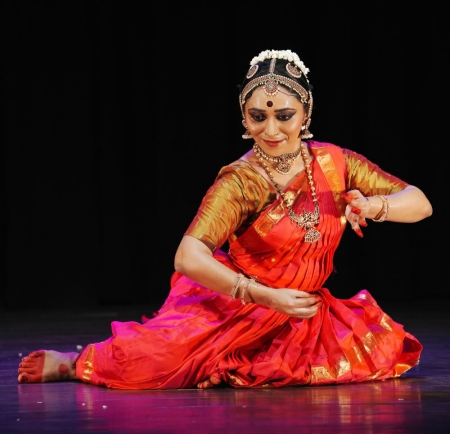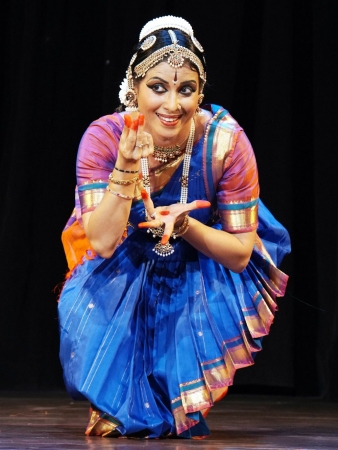
|   |

|   |
Delightful solo Bharatanatyam Margams from Ambalam - Satish Suri e-mail:satishism@yahoo.co.in Photos: Prof. K.S.Krishnamurthy May 18, 2024 Ambalam, under the leadership of Indira Kadambi, has established itself as a beacon of traditional Bharatanatyam, presenting solo margams that reflect the purity and discipline of this classical dance form, showcased through performances that are not only meticulously planned but also resonate with the ethos of Indian classical arts. The performances on the 2nd and 12th of May at Seva Sadan, Bangalore, are a testament to Ambalam's unwavering commitment to nurturing and propagating the rich cultural heritage of Bharatanatyam. Indira Kadambi, a distinguished performer and choreographer, brings her extensive experience and passion to the stage, ensuring that each presentation is imbued with the depth and finesse that Bharatanatyam demands. MEERA KRISHNA Meera Krishna's performance on May 2nd, under the auspices of Ambalam, was a testament to her dedication and skill. Trained at a prestigious institution like Kalakshetra, with a Masters degree from the University of Tamil Nadu, Meera began her recital with "Shantakaram Bhujagasayanam," a verse that pays homage to the tranquillity and magnificence of Lord Vishnu. This was followed by an Alarippu, a traditional dance sequence that highlighted the dancer's rhythmic accuracy and precise movements. Meera's choice of "Sami ninne korinanu raa..." as the centrepiece of her performance added profound depth to her portrayal, delving into the inner realms of devotion and longing, transcending mere physicality to offer a glimpse into the spiritual journey of the devotee. Seamlessly transitioning between different planes of expression, she stayed true to the essence of the song, embodying Lord Shiva's attributes with grace.  Meera Krishna The nayika's mood of deep yearning for Brihadiswara kept changing in tone. From being submerged in love, and declaring her unshakeable depth of feelings for the Lord, her tone in the charanam portion shifted to one of confidence and pride, as she proclaimed her unmatched beauty and worthiness as a companion for the divine. This bold declaration was not just a boast but a testament to her self-worth and the depth of her devotion, suggesting that her love is so profound that it elevates her to a status worthy of the Lord's attention. However, the final plea brought back the humility and vulnerability of the nayika, as she implored Brihadiswara to accept her, highlighting the cyclical nature of love and devotion that oscillates between pride and humility, assurance and supplication. Her attention to detail was seen from the nuances of sahitya to the precision of hand gestures and adavus. Coupled with her energy in executing the jathis composed by gurus Kittappa Pillai and Kandaswamy Pillai, Meera's performance became a captivating and immersive experience for the audience. Her execution of the complex Ashta Ragamalika in the varnam format was awe-inspiring, demonstrating not only remarkable technical skill but also a deep understanding of the composition's lyrical and emotional nuances. The Purandaradasa ragamalika "Chikkavane ivanu" offered a sprightly portrayal by Meera of the youthful exuberance of mischievous young Krishna, delighting in embarrassing the gopi with his audacious behaviour and cheeky questions. The late Kalanidhi Narayanan's choreography, renowned for its emotive power and grace, brought this portrayal to life, allowing the audience to experience the mischievous spirit of Krishna and his playful exchanges with the gopi. The impassioned exposition by the artiste of the Malayalam padam "Karuna cheyvan" by Irayimman Thampi, was a heartfelt ode to Guruvayurappan. The composition, set in Sri raga, was a profound expression of bhakti. Being in her mother tongue, heightened expressions and depth of delineation characterized the presentation. The padam's lyrics question the delay in divine intervention, reflecting a universal theme of seeking solace and answers in faith during times of distress. Meera's performance reached its grand finale with a brisk Thillana, a composition by Oothukadu Venkata Subbaiyer. This particular Thillana vividly portrayed Krishna's enchanting dance on the mighty serpent Kalia. As Meera gracefully moved across the stage, the contrasting gatis of tisra and chatusraha added a delightful lilt to her presentation. The Thillana's rhythmic power was undeniable, as Meera's precise footwork and intricate movements showcased her exceptional skill and agility as a dancer. Each beat of the music resonated with her every step, creating a mesmerizing synchronization with the melody. The ensemble of Rohit Bhatt's soulful vocals, the rhythmic mastery of nattuvangam by Indira Kadambi and Apeksha Kamath, the resonant beats of Harsha Samaga's mridangam, and the melodious flute by Nitish Ammanayya, together created a symphony, as each artiste brought their unique expertise and passion to the performance, weaving a tapestry of sound that elevated the overall experience. The collaboration of these talented musicians provided a rich musical backdrop that was both inspiring and memorable. AMBILI KRISHNAN The performance by Ambili Krishnan on the 12th of May was a profound display of classical artistry. The Pushpanjali in Gambhira Nattai, a creation of the late Guru Narmada, was a spiritual offering that set a reverent atmosphere. The narrative piece "Kadugola tarena chinnave" by Purandaradasa, performed with grace and vivacity, depicted the timeless tale of Lord Krishna's playful antics with his mother Yashoda. Through her expressive movements and intricate footwork, Ambili Krishnan brought to life the mischievous yet loving bond between the divine child and his doting mother. The varnam "Swamiyai vara solladi" in the ragam Purvikalyani is a classic piece that showcases a dancer's skill in both nritta and abhinaya. In this particular piece, the nayika (heroine) is portrayed in a state of deep longing and devotion, as she implores her sakhi (confidante) to bring Lord Kumaraswamy to her. The narrative beautifully intertwines mythology and devotion, depicting the Lord as the wise son of Sivakami who imparted the sacred syllable 'Om' to his father Shiva. The varnam also touches upon the playful aspects of the Lord's character, such as his marriage to Valli, where he adopts the guise of an old man to win her love. The emotional turmoil of the nayika, struck by Cupid's arrows, is palpable as she questions the Lord's apparent indifference to her suffering. The performance was enriched by the intricate jathi korvais and theermanams, which were executed with precision, adding a rhythmic complexity that complemented the emotive singing. This seamless blend of rhythm and emotion did not disappoint the rasikas.  Ambili Krishnan In the composition of Patnam Subrahmania Iyer's "Samayam ide ra ra" in raag Behag, a Javali unfolds, depicting the intricate emotions of a heroine torn between her husband and her forbidden love. As her husband departs on a work related journey, excitement fills her heart, anticipating the arrival of her beloved. However, upon his arrival, he hesitates at the doorstep, unsure of entering. The Javali delves into the depths of the heroine's emotions as she grapples with the complexities of her situation. Married to one man, she finds herself entangled in the throes of passion for another. Yet, the lover's hesitation at the threshold serves as a poignant reminder of the societal boundaries and moral dilemmas that enclose their illicit relationship. The Javali captured the heroine's anticipation, longing, and the bittersweet nature of her desires. As the Javali progressed, the music swelled, mirroring the intensity of the heroine's emotions. The dancer, adorned in vibrant attire, moved with grace and elegance, embodying the conflicting emotions that surge within her. Through subtle gestures and facial expressions, she conveyed the heroine's internal struggle, inviting the audience to empathize with her plight. "Aliveni", a classical padam composed by Maharaja Swati Tirunal, is a profound expression of love, set to the emotive tunes of Kurunji raga. The nayika's deep affection for Lord Padmanabha was depicted through her meticulous preparations and the vivid imagery of her surroundings, which she adorns in anticipation of his arrival. The raga's melancholic yet soothing melodies echoed her inner turmoil and devotion, as she oscillated between hope and despair. Her conversations with her sakhi reflected a blend of human emotions, tied to the divine. The Thillana in raga Mohana Kalyani, a composition of Lalgudi Jayaraman, provided a joyous and sparkling culmination to Ambili's dance performance. Performed with high energy, punctuated with verve and virtuosity, it was a fitting final ode to Lord Skanda. Abhishek N.S.'s soulful singing, harmonizing with the rhythmic beats of Harsha Samaga's mridangam, created a vibrant musical foundation. Indira Kadambi's guidance and precise nattuvangam, assisted by Sai Brinda Ramachandran, added a layer of visual storytelling to the auditory experience. The melodic flows from Nitish Ammanayya's flute and Gopal Venkatraman's veena wove together an intricate musical backdrop that enriched the dance performance by Ambili Krishnan.  Bangalore based Satish Suri is an avid dance rasika besides being a life member of the Music and Arts Society. |